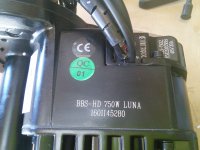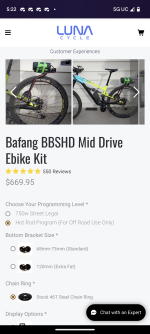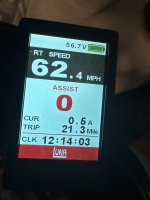kiltedcelt
100 W
So I have a BBSHD and for a while I ran it paired to an Alfine 8 internally geared hub. On a few occasions when I managed to run my battery down to the low voltage cut-off I found the bike to be very difficult to pedal, even in the lowest gearing combination that I had. It was like I was pedaling against resistance in the motor itself. I've NEVER opened this motor up and though I've owned it for something like almost 4 years, I only used it very lightly for a few months back in 2019-2020. Since then it's been uninstalled and I've periodically thrown the battery (an em3ev 52v 28.3 Ah triangle battery), on a charger to make sure it was maintaining charge. I'm building up a new recumbent trike to be my all around commuter/cargo hauler (with trailer towed behind for bulky loads), but mostly just commuter duty - approximately 120 miles per week.
I also have a Rohloff hub so I'm sticking with the mid-drive so I can continue to enjoy the use of my wonderful German-built hub. Plus, having a trike and riding in traffic, I think an internally geared drivetrain is a necessity. Being able to shift into any gear at a standstill is invaluable to me as is the all-weather performance and no fiddly chain shifting issues that I often get with derailleurs over time. Anyway, enough of that - specifics as to the BBSHD and the perceived "resistance." I've asked about this in the past and been told one of two things:
1. Mid-drives all have some resistance, that's what you're feeling (even though it seems excessive to me)
2. There's something wrong with MY mid-drive - open it up and diagnose.
So, I'm going with 2. I'm going to assume it's one of a few possible things - maybe I have overtightened the mount to the bottom bracket in the past as I have heard that can cause some feeling of resistance if you just put a "white-knuckle-death-grip" on the lock rings. I guess clutch could also be suspect. I've also read that these hubs can be woefully under-lubricated. So, before I install it on my trike, I want to buy every available possible spare and have those bits on hand before the install. Obviously I need that sort of big C-shaped gasket, but do I maybe need the inner motor housing gasket as well? What sort of grease should I buy to put in this? Should I invest in a replacement gear if I can find one in stock? I ride with PAS and I generally soft-pedal away from stops, and though I have a thumb throttle I don't use it that much except as a bit of a boost in some situations. Mostly I'm riding for exercise and just wanting to arrive a little bit quicker, and I want to make sure to get as much range out of my battery as possible. In the past, I've been able to get over 100 miles of range out of this battery when I used it with a geared hub motor, but I have no idea of what sort of range I can expect using it with the BBSHD. Since owning the BBSHD I've never ridden it long enough to get a feel for just how much range I can get out of my battery. Installing it on this trike will be the true test of range and reliablity.
Any other spares I might want to have on hand before I crack this thing open for an examination/servicing before installation? I've watched a few of the Luna videos about checking clutch and thrust bearing and such. Any other issues I should consider or videos I can watch to help diagnose this before install?
I also have a Rohloff hub so I'm sticking with the mid-drive so I can continue to enjoy the use of my wonderful German-built hub. Plus, having a trike and riding in traffic, I think an internally geared drivetrain is a necessity. Being able to shift into any gear at a standstill is invaluable to me as is the all-weather performance and no fiddly chain shifting issues that I often get with derailleurs over time. Anyway, enough of that - specifics as to the BBSHD and the perceived "resistance." I've asked about this in the past and been told one of two things:
1. Mid-drives all have some resistance, that's what you're feeling (even though it seems excessive to me)
2. There's something wrong with MY mid-drive - open it up and diagnose.
So, I'm going with 2. I'm going to assume it's one of a few possible things - maybe I have overtightened the mount to the bottom bracket in the past as I have heard that can cause some feeling of resistance if you just put a "white-knuckle-death-grip" on the lock rings. I guess clutch could also be suspect. I've also read that these hubs can be woefully under-lubricated. So, before I install it on my trike, I want to buy every available possible spare and have those bits on hand before the install. Obviously I need that sort of big C-shaped gasket, but do I maybe need the inner motor housing gasket as well? What sort of grease should I buy to put in this? Should I invest in a replacement gear if I can find one in stock? I ride with PAS and I generally soft-pedal away from stops, and though I have a thumb throttle I don't use it that much except as a bit of a boost in some situations. Mostly I'm riding for exercise and just wanting to arrive a little bit quicker, and I want to make sure to get as much range out of my battery as possible. In the past, I've been able to get over 100 miles of range out of this battery when I used it with a geared hub motor, but I have no idea of what sort of range I can expect using it with the BBSHD. Since owning the BBSHD I've never ridden it long enough to get a feel for just how much range I can get out of my battery. Installing it on this trike will be the true test of range and reliablity.
Any other spares I might want to have on hand before I crack this thing open for an examination/servicing before installation? I've watched a few of the Luna videos about checking clutch and thrust bearing and such. Any other issues I should consider or videos I can watch to help diagnose this before install?




